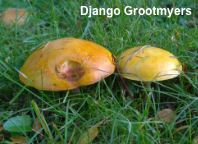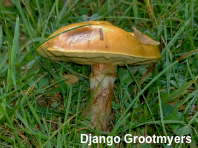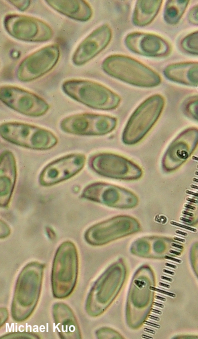| Major Groups > Boletes > Suillus > Suillus grevillei |

|
Suillus grevillei [ Basidiomycota > Boletales > Suillaceae > Suillus . . . ] by Michael Kuo Suillus grevillei is a European species associated with larch trees (especially European larch), characterized by its sticky yellow cap and the whitish, flimsy ring on its stem. Although the species is primarily European, it does travel, to North America and probably elsewhere, with planted European larch trees—and the collection featured here, from a park in Ohio, is one such example. Research by Nguyen and collaborators (2016) determined that the most prevalent North American grevillei-like species is Suillus clintonianus, which associates primarily with native North American larches and differs in several distinctive ways: its cap is generally brownish red, rather than yellow; its pileipellis features abundant reddish brown pigment globules (the pileipellis of Suillus grevillei does not); and its spores are slightly larger (although there is some overlap in the spore sizes of the two species). Suillus clintonianus is the "Suillus grevellei" featured in most North American field guides. Quick identifications based on cap color alone are complicated a bit by the fact that reddish specimens of Suillus grevillei and yellowish collections of Suillus clintonianus occur. But in both cases the specimens tend to be old; Suillus grevillei sometimes darkens with age, while Suillus clintonianus sometimes fades (Korhonen et al. 1993); thus observation of the pileipellis and spores, along with precise identification of the host tree, are probably needed for more confident identification. Suillus grevillei definitely appears, at least occasionally, in North America. Three collections of the species from Krull Park, in Niagra County, New York (identified by bolete specialist Ernst Both) group with European collections in the phylogram of Nguyen and collaborators. These three collections had been previously used, along with a fourth from Krull Park, identified as Gastrosuillus laricinus (a secotioid, truffle-like mushroom), to demonstrate that Gastrosuillus laricinus was actually just a mutated form of Suillus grevillei (Barua et al. 1992, Kretzer & Bruns 1997). But all four of these New York collections appear together with Suillus grevillei collections from Sweden, Poland, Portugal, and Italy in the Nguyen et al. analysis, clearly separated from Suillus clintonianus. The extent to which Suillus grevillei actually occurs on our continent is undetermined, and careful molecular and morphological study of well-documented herbarium collections would probably be needed to answer the question. Based on a very unscientific perusal of photos of North American collections online, yellow-capped, possible true Suillus grevillei collections (potentially mislabeled as Suillus clintonianus) appear to be limited to the mid-Atlantic and Great Lakes states. Thanks to Django Grootmyers for collecting Suillus grevillei for study; his collection is deposited in The Herbarium of Michael Kuo. Description: Ecology: Mycorrhizal with larch (species of Larix)—especially European larch; growing gregariously; terrestrial; summer and fall; originally described from Great Britain; widespread in Europe; occasional in North America (especially with planted European larch); reported from New Zealand. The illustrated and described collection is from Ohio. Cap: 5–9 cm across; convex becoming broadly convex; sticky when fresh; bald; orange-yellow to bright yellow; the margin paler yellow, with a tiny sterile extension. Pore Surface: Yellow; not bruising; 2–3 angular pores per mm, not boletinoid in arrangement; tubes to about 10 mm deep. Stem: 5–8 cm long; 1–2 cm thick; more or less equal; yellow, with brown glandular dots above the ring; brownish below; ring pale yellow to nearly whitish, collapsing; basal mycelium pale yellow to whitish. Flesh: Yellow; unchanging when sliced. Odor and Taste: Not distinctive. Spore Print: Reported (Breitenbach & Kränzlin 1991) as olive brown. Microscopic Features: Spores 7–10 x 3–4 µm; boletoid-fusiform; smooth; hyaline in KOH. Basidia 24–27 x 4–5 µm; subclavate; 4-sterigmate. Cystidia in gelatinized, orange-brown bundles; poorly defined individually. Pileipellis an ixocutis; pigment globules not found; elements 2–4 µm wide, smooth or slightly roughened, hyaline to faintly yellowish in water and in KOH. Clamp connections not found. REFERENCES: (J. F. Klotzsch, 1832) R. Singer, 1945. (Phillips, 1981; Breitenbach & Kränzlin, 1991; Barua et al., 1992; Both, 1993; Korhonen et al., 1993; Kretzer & Bruns, 1997; Buczacki et al., 2013; Klofac, 2013; Nguyen et al., 2016; Gminder & Böhning, 2017; Knudsen & Taylor, 2018; Noordeloos et al., 2018; Læssøe & Petersen, 2019; Kibby, 2020.) Herb. Kuo 10151601. This site contains no information about the edibility or toxicity of mushrooms. |
© MushroomExpert.Com |
|
Cite this page as: Kuo, M. (2022, March). Suillus grevillei. Retrieved from the MushroomExpert.Com Web site: http://www.mushroomexpert.com/suillus_grevillei.html |



